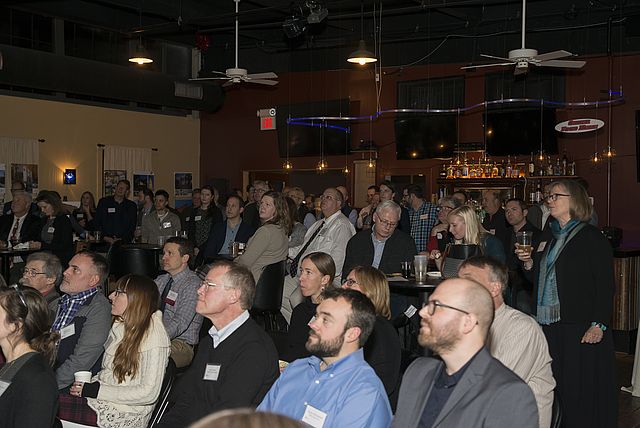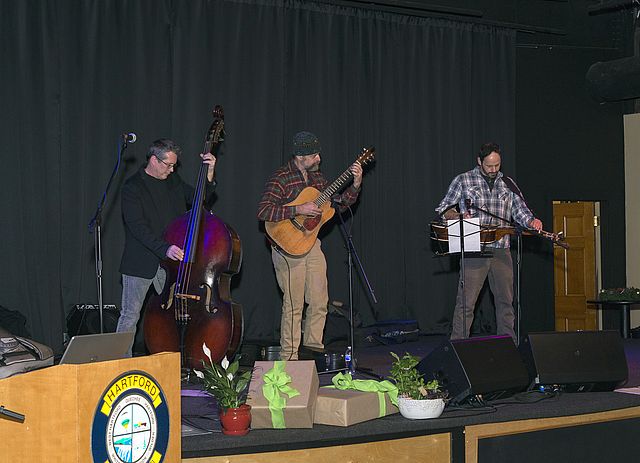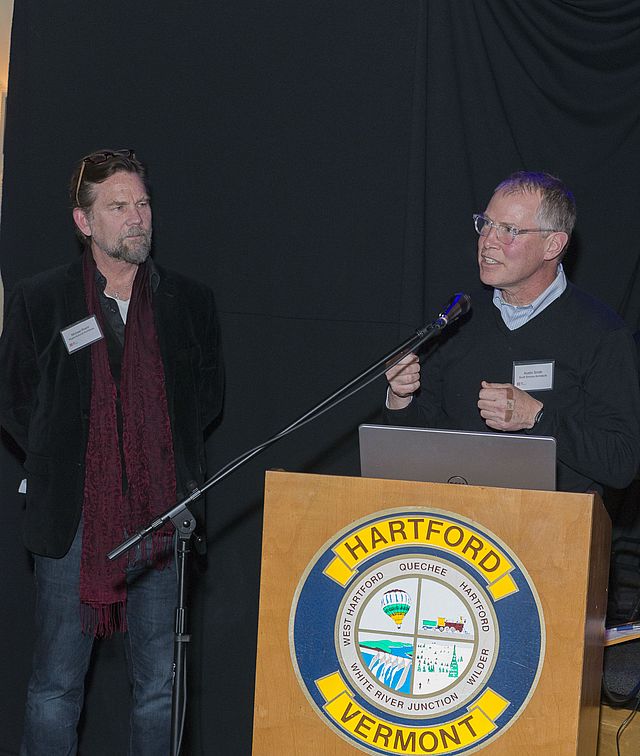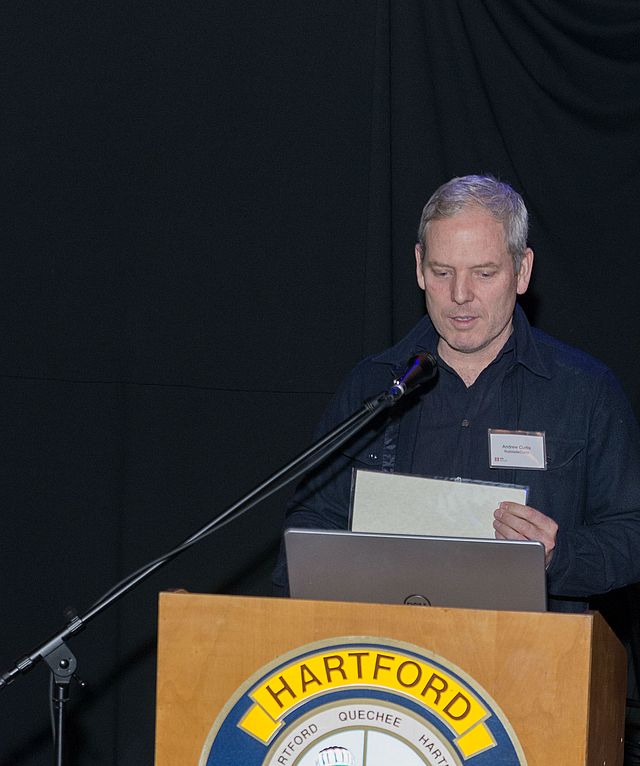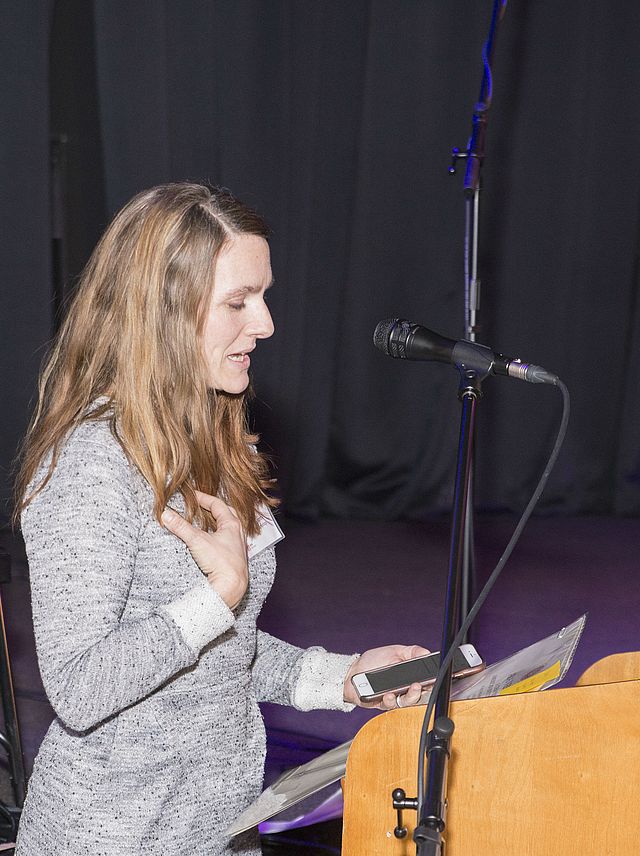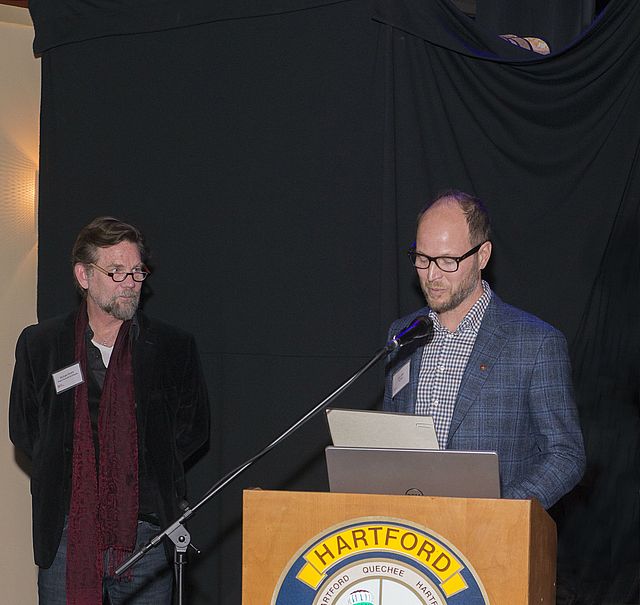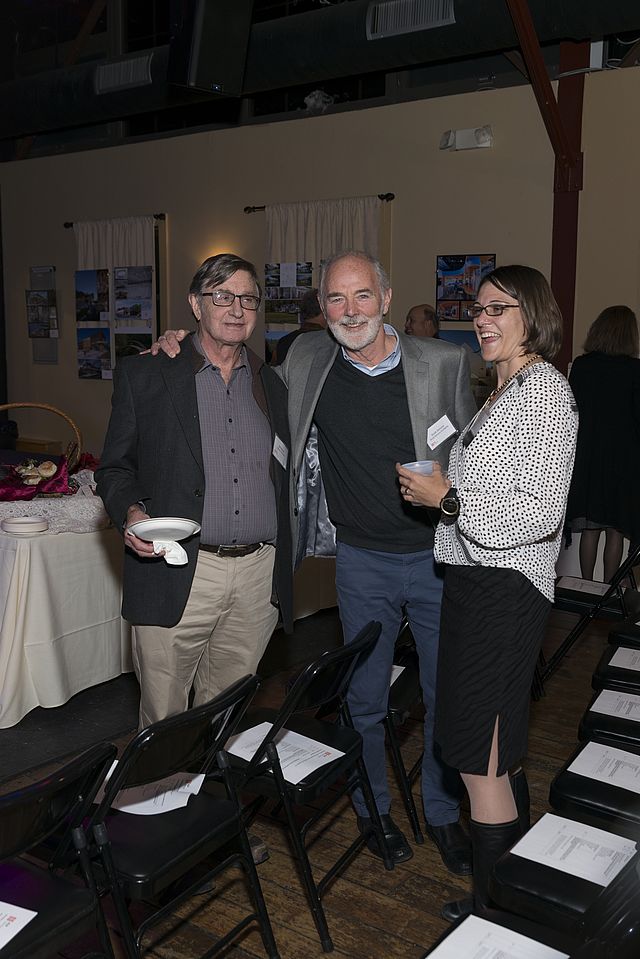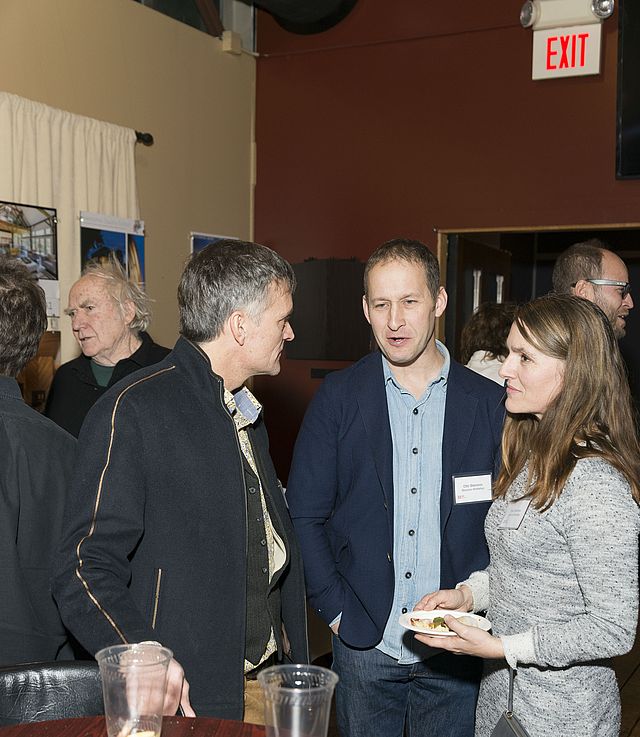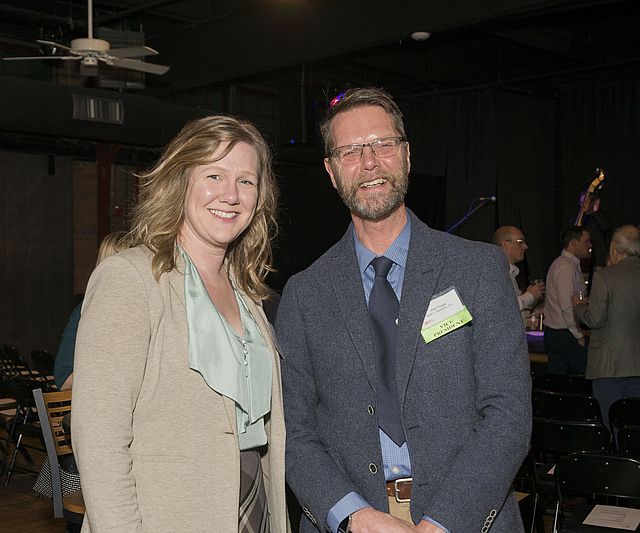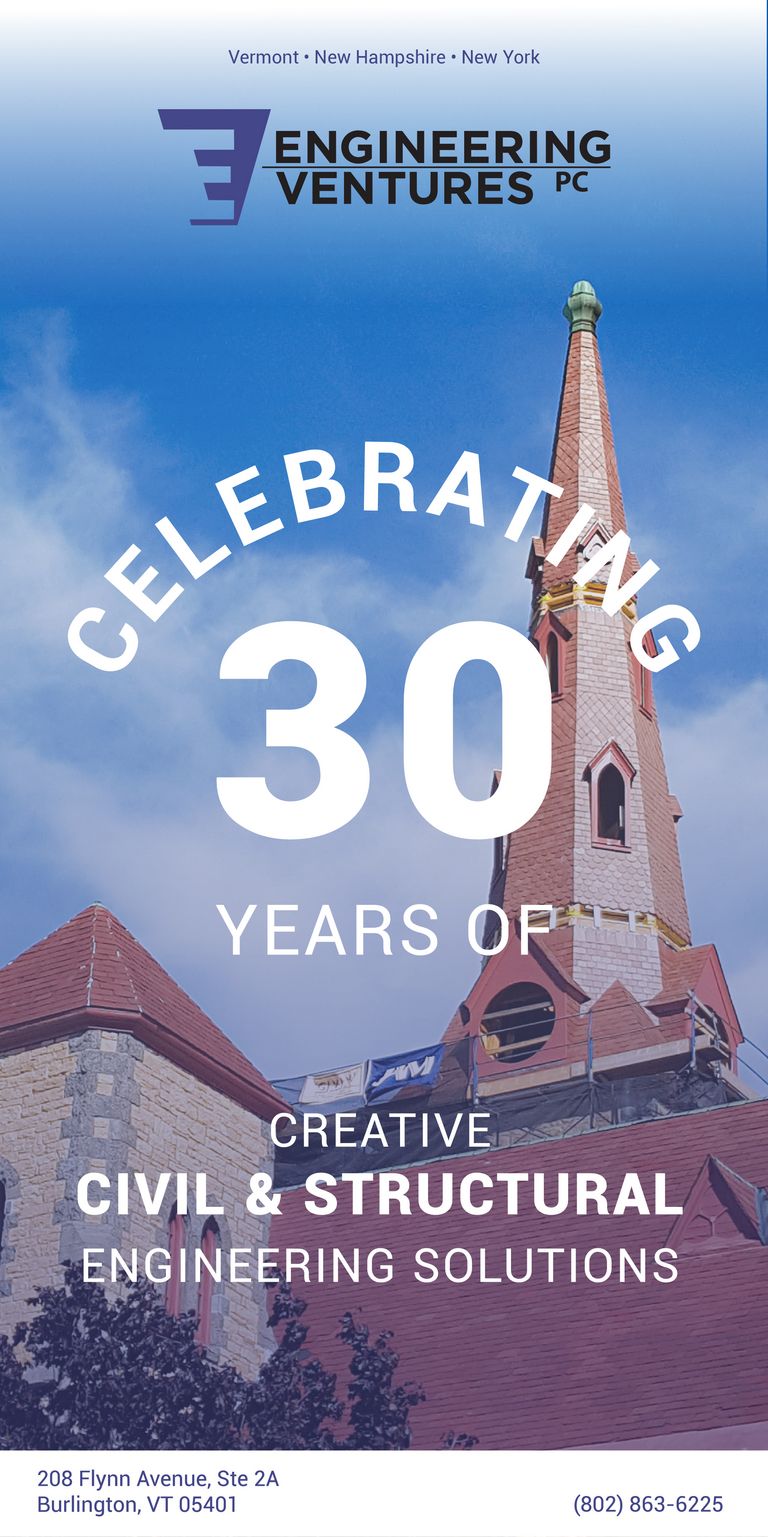AIA Vermont celebrated this year’s winners of the Excellence in Architecture Awards at the Engine Room, a former train depot- turned music hall in White River Junction, on December 13. Cocktails and hors d'oeuvres kicked off the evening, with the Hot Pick’n Party bluegrass band bringing a fun musical accompaniment to the mingling. Guests were asked to vote at the event for their favorite awards entry, all of which were displayed alongside the eastern wall of the venue and received serious consideration from attendees.
At 6:45, the formal meeting began, which included thank yous to the event’s underwriter, Windows and Doors by Brownell, as well as the four bronze level sponsors: Charron, Crown Point Cabinetry, Engineering Ventures, and Poole Professional. A summary of the year in review was given by Chapter President, Megan Nedzinski, AIA, and official business was taken care of, including several approved changes to AIAVT’s bylaws. (More info <link news-events news-details post aiavt-approves-changes-to-chapter-bylaws>here.) Members also approved the appointment of one new individual to the AIAVT Board of Directors for 2019: Lealoni Coathup, Assoc. AIA, of TruexCullins, who will be taking on the position of EPN Director.
The winners of the 2018 Design Awards were selected by a jury comprised of members of AIA Minneapolis: Michael Roehr, AIA, RoehrSchmitt Architecture; Dan Hollingsworth, AIA, Thor Architects; Shida Du, AIA, BWBR; and Michael Tierney, AIA, Snow Kreilich Architects.
The jury was asked to consider granting awards based on design excellence at three levels: Honor (first), Merit (second), and Citation (third). The Jury convened in Minneapolis, MN, where AIAVT Board Member and Awards Committee Chair, Ward Joyce facilitated a 4 hour review process. Head Juror, Michael Roehr travelled to White River Junction to present the winners with their awards at the AIAVT Annual Meeting Event.
One of two Honor Awards was received by RobitailleCurtis, for “Atrium Town Home”, a 2753 sq ft single family home located in Westmount, Quebec, Canada. Originally built in 1978, this townhome was in need of significant updating. The clients, a young family, wanted updated modern finishes, unique design features, and an open convivial layout with the ability to close off space so their Great Danes and cats could be kept out of the kitchen and living room.
The project’s primary material palette needed to be durable and not require constant maintenance. The Jury said of this project, “with a spare, monochromatic material palette that in another project might easily have been excessively severe, this townhome interior brought a significant dose of play and whimsy to rescue the project from sterility. Conversely, the restraint of the architecture kept that playfulness from becoming too cute or gimmicky.” Other aspects that were admired by the jury were the “upending of typical residential expectations, elegant detailing, and balance of cool and warm, hard and soft textures.” For photos and details, please visit <link awards>2018 awards.
The second Honor Award was received by Scott Simons Architects for the “Brattleboro Music Center.” In 2016, Scott Simons Architects was approached by the client with this challenging problem: Design education and performance spaces for teaching children classical chamber music using an abandoned elementary school, and complete the project with a shoestring budget of $216/SF. The client expressed the following project goals: Provide superior acoustics in all education, practice, and performance spaces. Design to the acoustical needs of classical chamber music – a tall square-sectioned volume with varied interior surfaces, absorptive rear wall and a projecting balcony. Design the Center to be a community resource, accessible to all.
The design re-purposes the old elementary school for teaching studios, offices, and support space. An addition to the front of the existing building provides a 70-seat recital hall, entry lobby, and a new identity. A canopy connects this space with a new, stand-alone structure housing a 224-seat chamber hall with a dedicated lobby, restrooms, green room, and support space.
The Jury commented, “Here the simple strategy of leveraging the new addition as a mask for the existing structure allows for a complete and cost-effective transformation of the building. The utilitarian, low-maintenance exterior is enlivened by deft, rhythmic massing that takes advantage of the opportunity to express the gathering and performance spaces within, and there is a gentle crescendo from the bright, open spaces that greet the visitor to the darker, richer, more intimate performance spaces at the heart of the center.” For photos and details, please visit <link awards>2018 awards.
The Richmond firm Birdseye Design received a Merit Award for “ADK Camp,” located in New York State’s Adirondack Park, is a private residence on Brant Lake, owned by the same family for four generations. The 5-acre site is defined by two existing boathouses, a tree-lined carriage road, and a vintage waterfront cabin. The structure replaces a dilapidated and structurally unsound building. In the spirit of Great Camp buildings, the minimalist-designed residence, in plan, anchors the historic buildings of the site to create a new central hub for the residents. The Jury commented that “[ADK Camp] was one of the few projects that thoroughly redefined its site with the introduction of a new building that clearly contrasted in scale and expression with the existing buildings on the site, casting them into entirely new light. While significantly larger than the existing adjacent structures and establishing a new center of gravity for the site, the house modulates this potentially jarring contrast by reducing this imposition through its broad, low-slung form and dark color. The house stands back away from the lakefront, retreating just into the edge of the woods, enveloped in shadow. The historic boathouses at the water’s edge stand out against this new building.” For photos and details, please visit <link awards>2018 awards.
A Merit Award was received by Stonorov Workshop for “Remote Lake Camp.” The Lake Camp is located on a sloped site on a lake in the Adirondack Mountains. With no road access to the site, everything, (excavators, large timbers, solar panels, etc.), must be floated in by small boat or raft. As the site is off-the-grid, the camp’s limited electrical requirements run off of a removed solar field that uses an area cleared for the septic field. This Adirondack Lake has been in the client’s family for five generations. The camp is elevated in the trees and touches lightly on the sloping ground below. The basic building system is wood-clad timber frame. Natural light is paramount. Only materials in their rawest serviceable form, as locally sourced as is possible, were used in the construction. With a footprint of less than 600 square feet, the Lake Camp accommodates two bedrooms and sleeps up to six people. The main space extends out to the deck and landscape beyond with a 9 x 12 foot window and large door. The Jury was impressed with how “the project itself clearly remained true to this remoteness and isolation, and ultimately appeared to almost have grown in place from the same handful of elements that comprise its surroundings.” They also noted that “the rustic character of the cabin was nicely contrasted with the modern approach to opening up the wall with large expanses of glass, which created a superior quality of daylighting and connection to the exterior, unusual in such rustic structures that more typically feature punched windows.” For photos and details, please visit <link awards>2018 awards.
A Citation Award was received by Birdseye Design for their project, “Hygge.” Hygge (pronounced hue- guh) is a Danish word used to acknowledge a special feeling or moment. It can be alone or with friends, at home or out, ordinary or extraordinary but it is always cozy, charming or special. Located along Vermont’s eastern shoreline of Lake Champlain in a densely populated lakeside neighborhood, the residence is situated on the footprint of a former residence [that was] demolished. The new house is a single-story structure with 850 square feet of interior space, divided into common areas; lake-side to the west ,bedrooms and utility facing street-side to the east. An extended gable with storage wing walls provides privacy, protection and shelter for the living areas and covered deck. Storage space is designed in to the attic trusses and the crawl space houses the building infrastructure.
Disturbance was limited to the existing footprint, mitigating stress on the surrounding ecosystem and neighborhood. The Jury commented, “a clean, virtually platonic diagram pares the program of this little house down to some primal relationships, dramatizing the boundary between land and water, earth and sky. Once inside, the views to the sides and behind are restricted: The house presents the lake to you and you to the lake. The image of the context of surrounding houses was important to the jury, emphasizing the quiet, elegant simplicity that is the elusive result of a great deal of rigor and restraint. The little house sits like a moment of mindful calm amidst the hustle and bustle of the workaday world.” For photos and details, please visit <link awards>2018 awards.
A Citation Award was received by RobitailleCurtis for “Hampstead House”, on which the jury commented, “This project represents a complete transformation of the interior of this house with great attention paid to every detail and element.” For this house renovation in the Hampstead neighbourhood of Montreal, RobitailleCurtis was hired to assist a young doctor and his family with the modernization of a home that had been owner occupied for more than 40 years. A vintage 1960's property, the existing house was divided into a series of small rooms with a decor from another era. The clients wanted to freshen up the look and feel of their new home and granted the architects full-license to re-imagine how best to transform the house into a home designed for a thriving modern family. The jury felt that “The restraint of the color and material palette draws one’s attention to the smallest details and the high level of craft. The quality of the daylighting was particularly strong and clearly a priority in the design, creating an ethereal space that seemed to suffuse a gentle illumination from every corner”, and went on to comment that “the space has the character of a stage or set that, while striking in its own right, would comfortably settle into the background once occupied, receding to frame the action of the occupants whose activity would bring the space to life.” For photos and details, please visit <link awards>2018 awards.
New for this year’s Annual Design Awards was the Peers’ Choice Awards. Attendees at the AIAVT Annual Design Awards event on December 13th voted for their favorite projects, based upon the design boards on view at the event, which showcased all 36 of the projects entered. The 2018 Peers’ Choice Winners were:
First Place: Birdseye Design for “Lift House”, a 5,185 square foot single family residence located in Killington, Vermont.
Second Place was tied between: Elizabeth Herrmann for “Little Black House”, a 1,120 square foot house designed for a family of four located in Fayston, Vermont, and gbA Architects’, “Red Clover Common Housing”, a multi-family project located in Brattleboro, Vermont that consists of 55 apartments for low-income elderly and disabled members of the community.
Project posters of all entries will be displayed throughout 2019 at various locations around the state. Details and images for all of the above projects can be found at: <link awards>www.aiavt.org/awards/18awards/
Following the Awards Presentations, Rolf Kielman took to the podium to honor fellow AIAVT member, Brian Mac, who was elevated to the prestigious College of Fellows in 2018. For details, please see the article, <link news-events news-details post brian-mac-honored-at-aiavt-annual-meeting>Brian Mac Honored at AIAVT Annual Meeting.
To round out the evening, Megan Nedzinski invited Lisa Rovner to the podium. Lisa, one of AIA Vermont’s longest serving board members, announced her acceptance of a position with Davis Brody Bond in Manhattan this fall. Despite recently moving to New York City, Lisa made the journey back to Vermont to honor Carol Miklos’ 8 years as AIAVT’s Executive Director, and spoke about the challenges and successes the organization navigated under Carol’s leadership. Carol worked with incoming Executive Director, Sarah O Donnell this summer to help ensure a smooth transition.
Megan Nedainski read a note from Jesse Beck of Freeman French Freeman, who was unable to attend: “Carol filled the legacy shoes of (former AIA VT Executive Director) Hanna Williams with grace and skill. Her abilities and success during this transition meant that AIAVT did not skip a beat! I enjoyed having her at the helm and bringing us to a new level.” Megan announced “As a lasting honor to the years of service to our organization, I’m pleased to announce that AIA Vermont has created an award to carry Carol’s name into the future. The Carol Miklos Community Outreach Grant will be available to individuals and organizations throughout the state through an application process slated to begin 2019 with the purpose of fostering outreach and engagement with architecture and design in our Vermont communities.”
Lastly, our chapter’s incoming president, Joel Page, AIA, outlined his agenda for 2019. Joel is focused on strengthening AIAVT’s relationships to its members, partners, and the community at large, and developing a strategic plan and vision for the future. Joel emphasized his desire to broaden internal as well as external outreach to ensure that AIAVT has a seat at the table and the position to influence statewide issues.

